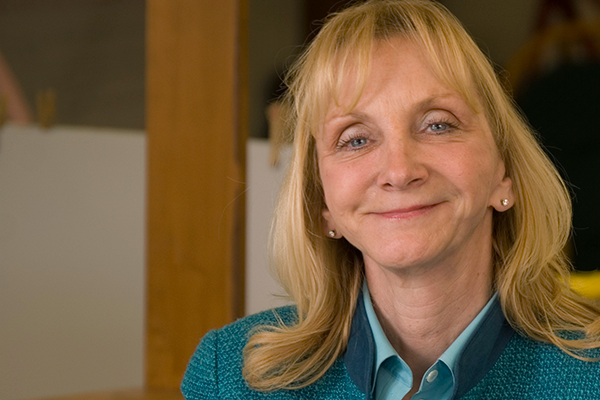Business professor Kathryn Ready’s social entrepreneurship course casts new perspective on non-profits
By Margaret Cox
If any student enrolled in Dr. Kathryn Ready’s social entrepreneurship course was expecting to sit in a traditional classroom, reading standard textbooks, and listening to lectures, they were definitely mistaken.
This unique course, which focuses on the business aspects of not-for-profit- organizations, takes hands-on learning to a whole new level. Between dynamic guest speakers to numerous field trips and the intense analysis of a Winona area community service organization, students are engaged in every part of the learning process.
“Winona State University is pushing the boundaries to enhance learning opportunities,” says Brent Lichtenberg ’14. “Offering this class, where we go into non-profit organizations and study, review, analyze, and recommend business objectives is vital to our learning experience.”
For Lichtenberg, it was the entrepreneurial aspect of non-profits that intrigued him, and eventually lead him to enroll in the course. For Tyler Utesch ’14, a budding entrepreneur himself, the course was a chance to get a different perspective on owning a business. For Amy Rick ’14, it was a word-of-mouth recommendation from a friend who took the course the year before.
Regardless of the reasons why they enrolled, they agree that what they learned through the social entrepreneurship course went far beyond the classroom. “As a business major, you are generally taught about how to make the most money, how to advertise things and be the best business out there,” explains Rick.
“This class taught me that it is not just about the money. The people who run nonprofit organizations are successful and happy and had to work extremely hard to get there.”
According to Ready, social entrepreneurship is the pursuit of innovative solutions to social problems. Often, an outcome of these efforts is the establishment of a mission-based organization for the purpose of implementing those solutions. While social entrepreneurial activities may be tackled by for-profit businesses, historically, many non-profit organizations have been created in response to societal issues that needed attention.
A native of southeast Minnesota, Ready came to Winona State in 2006 and immediately started looking for ways to connect students with the community. As she researched social entrepreneurship programs at other schools across the country, she discovered that this type of college course was anything but common, and textbooks on the subject were extremely limited.
Undeterred, Ready set about creating a curriculum that included readings from a variety of books and studies on how to start and run a non-profit organization. She created lessons on the business issues that non-profit organizations face, such as developing a mission statement, managing paid and volunteer staffs, securing business loans and obtaining grants, and determining marketing and pricing strategies.
She developed a framework for students to form groups of 4-6 members and select a non-profit organization of their choice that they could volunteer with and study in depth. Students would analyze topics related to the non-profit throughout the semester; by the end, they would submit a major paper with recommendations and present their findings to the class and to management and board members of the organization studied.
Ready’s work in creating the course paid off, the curriculum was approved, and the first social entrepreneurship course at Winona State was offered in the fall semester of 2006.
From the start, students welcomed the opportunity to learn about social entrepreneurship and the course quickly became a popular elective. Ready supplemented the class by arranging tours of local non-profit organizations and inviting non-profit leaders to serve as guest lecturers in her classroom.
They explained firsthand how they came up with the idea for their organization, and the work that went into launching and sustaining it. The result was a dynamic interaction between students and community members. “Students pick up on the passion and excitement from these non-profit leaders more than they ever could from reading about it in a book,” explains Ready.
For Rick, there was an instant connection to Carla Burton, the founder and director of Grace Place, a local organization that assists struggling families with shelter, counseling, spiritual needs, and parenting skills.
“I had been in the Grace Place retail store a few times with friends, so I knew what it was about. Exploring it through the social entrepreneurship course made me see a whole different side to it,” says Rick. “Carla is an extremely caring woman who works hard to keep Grace Place running as smoothly as it does today. It is a lot of work, but the work seems very rewarding.”
Lichtenberg connected with Bill Wichmann, founder of the Winona Chapter of Let’s Go Fishing with Seniors. “Let’s Go Fishing is not as well known as other non-profit groups, and it needed volunteers,” says Lichtenberg. “I enjoy the outdoors and fishing, so this was a good fit for me.”
Because the organization was not very well known, Lichtenberg had to pitch the idea to fellow classmates. His plan worked: three students signed up to study the organization, develop a promotional video that could be used to raise funds, and volunteer on one of the fishing cruises.
During the process, Lichtenberg learned the importance of fundraising and grant writing, especially for non-profits. “The non-profits have to meet certain requirements to qualify for grants, and they have to apply for them,” he says. “Without that funding to rely on, many of them would fail.”
Utesch, who studied the Winona Area Humane Society, learned how critically important the mission statement is to a non-profit organization. “The mission statement really represents an organization’s values. It’s what drives a non-profit,” Utesch says.
“It’s a big deal to donors. They want to know where their money is going, and that it is supporting the values that they believe in. Sometimes, a non-profit has to realign its mission with its activities if it gets off track.” To help support the Winona Area Humane Society, Utesch and his group assisted with the annual fundraising auction and created a YouTube video to encourage volunteerism at the shelter.
Each year, Ready tries to introduce a special focus to the course. Past years have included creative fundraising, grant writing, and more recently, the use of social media as a marketing tool.
“Every semester, I am truly amazed at how much the students grow, the innovative ideas they present, and what they are capable of giving back to the community,” says Ready. “Non-profits don’t necessarily have a lot of resources, nor do students, yet so many are willing to continue volunteering, accept unpaid internships, or serve on nonprofit task forces and boards after the semester ends. It says a lot about their interests, integrity, and what they value in life.”
Ready is also quick to mention that the need is always present. “In addition to volunteering, many organizations are looking for qualified, interested board members with specific skills to provide advice and support,” she says. “In terms of jobs, the non-profit sector represents 10-percent of employment in the United States. It’s a growing area for job opportunities.”
Students agree that they will take the lessons they learned and the skills that they developed in the social entrepreneurship course with them when they leave Winona State.
“Giving back is a part of my lifestyle now,” says Utesch. “I encourage students and alumni to get out of their comfort zone and volunteer. Pick an organization, really get involved, and see where it leads you!”
If you are interested in serving as a guest speaker in a social entrepreneurship class, please contact Dr. Kathryn Ready at kr****@****na.edu.


